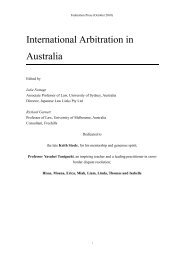Gillard Government Trade Policy Statement - Australian Industry Group
Gillard Government Trade Policy Statement - Australian Industry Group
Gillard Government Trade Policy Statement - Australian Industry Group
You also want an ePaper? Increase the reach of your titles
YUMPU automatically turns print PDFs into web optimized ePapers that Google loves.
During the present economic recovery, further trade liberalisation through completion of the Doha Roundwould create more jobs and prosperity, averting a zero-sum squabble over the distribution of a fixednumber of jobs and a set amount of prosperity. Yet major and emerging powers appear indifferent to theseopportunities. In this sea of indifference, the range of possible approaches to trade negotiations is boundedby: continuing to press hard for a successful completion of the Doha Round and the preservation of theglobal trading rules; and giving-up on the multilateral system and negotiating discriminatory bilateral andregional trade deals.Applying the principles and disciplines of the <strong>Gillard</strong> <strong>Government</strong>’s trade strategy – and consistent with theProductivity Commission’s 2010 report on trade agreements - the <strong>Government</strong>’s negotiating agenda willsteer a middle course of championing and protecting the multilateral system while seeking to negotiate highquality,truly liberalising sectoral, bilateral and regional trade deals that do not detract from but support themultilateral system.The <strong>Government</strong>’s trade negotiating priorities are set out below. Later this year the <strong>Government</strong> will againassess each set of trade negotiations against the principles and disciplines outlined in this <strong>Trade</strong> Strategy, inthe light of progress on the various negotiations.MULTILATERAL AGREEMENTS OFFER THE LARGESTBENEFITSThe Doha RoundA multilateral trade deal offers the greatest prospective benefits. Successful completion of the Doha Roundwould create a new wave of global trade liberalisation and strengthen the integrity of the global trading rulesto achieve greater gains from trade.Global prosperity is maximised in a global market observing global trading rules. Multilateral tradeliberalisation allows countries to specialise according to their comparative advantage, creating more jobs andprosperity instead of simply redistributing a fixed number of jobs and a fixed amount of prosperity amongthe countries of the world. By avoiding discrimination, multilateral trade liberalisation avoids potentiallycostly trade diversion to countries that are not the best at producing particular goods and services. As PeterCorish, former President of the National Farmers Federation observed:“There is only one way we will get any meaningful reform, and that is through results at theWorld <strong>Trade</strong> Organization. If you do a deal in the World <strong>Trade</strong> Organization then you effectivelyget 144 FTAs all at once.”Mr Corish made that statement in 2002. Today, the figure would be 153 trade agreements all at once, sincethere are now 153 members of the World <strong>Trade</strong> Organization. In fact, it would be even better than this,because Australia’s trade with each of the 153 countries would not be tied up with restrictive rules of originthat are deployed in discriminatory trade deals.The <strong>Gillard</strong> <strong>Government</strong> will continue to press for an ambitious, comprehensive outcome of the Doha Roundthat liberalises trade in agriculture, manufacturing and services.ASIA PACIFIC ECONOMIC COOPERATION (APEC)The <strong>Gillard</strong> <strong>Government</strong> will continue to champion the Asia Pacific Economic Cooperation (APEC) forum,which was established in 1989 at the initiative of the Hawke <strong>Government</strong>. Though not a trade negotiatingforum, APEC has proven to be an effective grouping for trade liberalisation in the Asia-Pacific region.Following the adoption in 1994 of the so-called Bogor Goals for free and open trade and investment in theAsia-Pacific (by 2010 for industrialised economies and by 2020 for developing economies), countries of theregion have gradually lowered their tariffs, confident that other countries were lowering theirs too. By 2009,APEC economies had reduced their tariffs to an average of just over 6 per cent, down from around 16 percent in 1988.Longer term, Australia and other APEC members aspire to the formation of a Free <strong>Trade</strong> Area of the Asia-10



